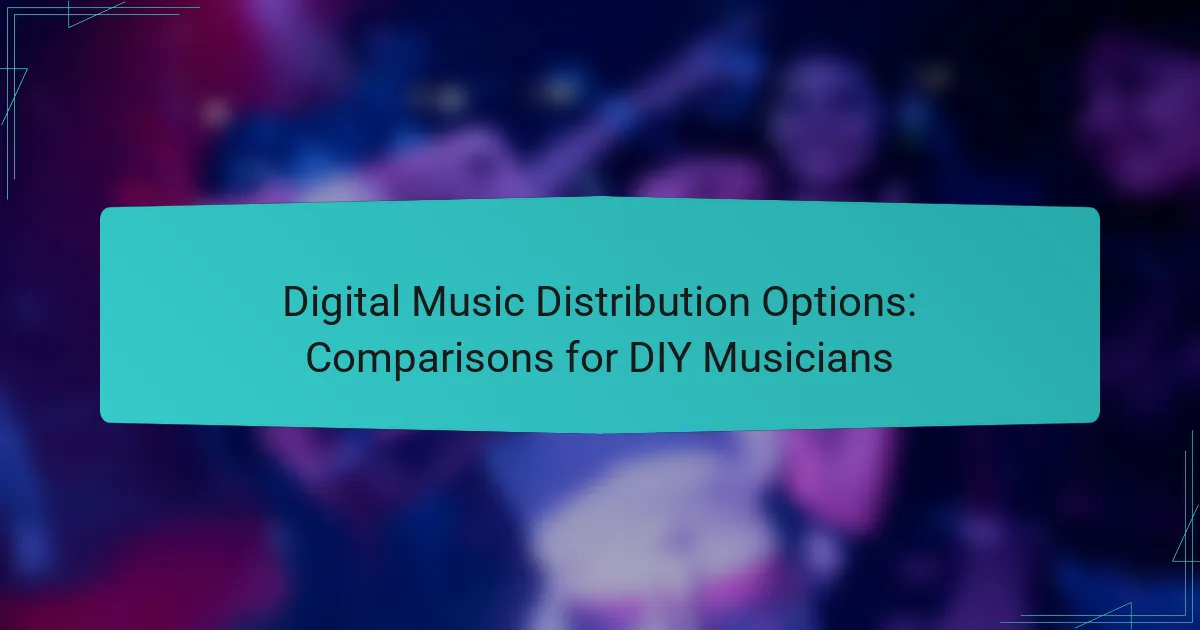For emerging musicians, choosing the right digital music distributor is crucial for successful music release and promotion. Platforms like DistroKid, TuneCore, and CD Baby offer user-friendly services, fair revenue splits, and extensive distribution networks, making it easier for artists to reach their audience. Prioritizing features such as cost-effectiveness, global reach, and reliable customer support can greatly enhance an artist’s ability to share their music with the world.

What are the best digital music distributors for emerging musicians?
The best digital music distributors for emerging musicians include platforms that offer user-friendly services, fair revenue splits, and broad distribution networks. Key players like DistroKid, TuneCore, CD Baby, Amuse, and LANDR each have unique features that cater to different needs and budgets.
DistroKid
DistroKid is known for its straightforward pricing model, allowing artists to upload unlimited tracks for a flat annual fee. This makes it ideal for musicians who release music frequently. Additionally, DistroKid offers rapid distribution to major streaming services like Spotify and Apple Music.
One notable feature is the ability to split earnings with collaborators automatically, which simplifies financial arrangements. However, artists should be aware that DistroKid takes a percentage from any additional services, such as YouTube Content ID.
TuneCore
TuneCore operates on a pay-per-release model, charging artists for each single or album uploaded. This can be beneficial for musicians who release music infrequently or want to maintain control over their catalog. TuneCore also provides detailed sales reports and analytics.
While TuneCore offers a comprehensive distribution network, its fees can add up over time, especially if an artist plans to release multiple projects. Musicians should weigh the upfront costs against potential earnings from their music.
CD Baby
CD Baby is a well-established distributor that offers both digital and physical distribution options. Artists can choose between a one-time fee for digital distribution or a subscription model. CD Baby also provides services like CD manufacturing and sync licensing.
One advantage of CD Baby is its extensive support resources, including tutorials and marketing tips. However, artists should note that CD Baby takes a percentage of sales, which can impact overall earnings.
Amuse
Amuse offers a unique approach by providing a free distribution option alongside premium services. The free tier allows artists to distribute their music without upfront costs, making it accessible for emerging musicians. However, the premium plan offers additional features like faster release times and advanced analytics.
Amuse also has a focus on artist development, offering opportunities for funding and promotion. Emerging musicians should consider whether the free service meets their needs or if the premium features justify the cost.
LANDR
LANDR is primarily known for its online mastering services but has expanded into music distribution. It offers a subscription model that includes unlimited distribution and mastering, which can be appealing for artists looking for an all-in-one solution. This can save time and money for musicians who need both services.
While LANDR’s mastering quality is generally well-regarded, artists should evaluate whether its distribution network meets their expectations. Additionally, the subscription model may not be cost-effective for those who release music infrequently.
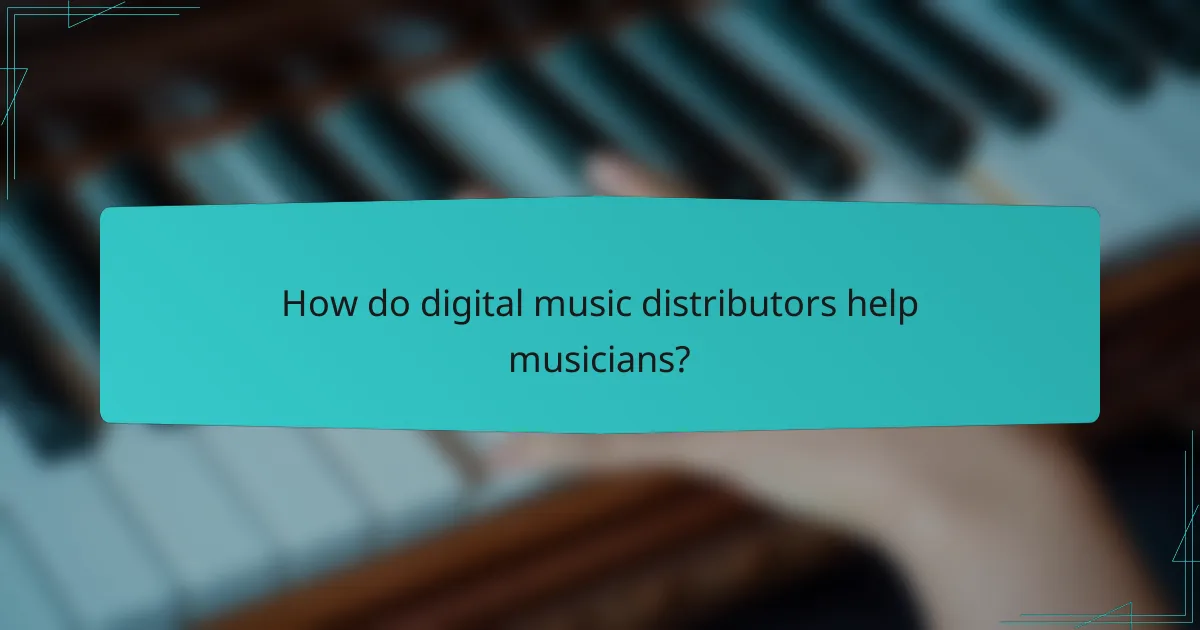
How do digital music distributors help musicians?
Digital music distributors assist musicians by providing a platform to release their music across various streaming services and online stores. They simplify the process of getting music to listeners while ensuring that artists receive their earnings from sales and streams.
Streamlined distribution
Streamlined distribution allows musicians to upload their music once and have it distributed to multiple platforms, such as Spotify, Apple Music, and Amazon Music. This saves time and effort compared to managing each platform individually.
Many distributors offer user-friendly interfaces that guide artists through the upload process, including metadata entry and artwork submission. Choosing a distributor that covers a wide range of platforms can maximize an artist’s reach.
Royalty collection
Royalty collection is a crucial feature of digital music distributors, as they ensure that musicians receive payment for their work. Distributors track streams and sales, collecting royalties on behalf of the artists.
Typically, distributors take a percentage of the earnings, which can range from around 10% to 30%. Artists should review the terms carefully to understand how royalties are calculated and when payments are made, as this can vary significantly between distributors.
Analytics and reporting
Analytics and reporting tools provided by digital music distributors help musicians understand their audience and track performance. These tools offer insights into streaming numbers, geographic locations of listeners, and demographic data.
By analyzing this data, artists can make informed decisions about marketing strategies and future releases. Regularly reviewing analytics can help identify trends and opportunities for growth in their music career.
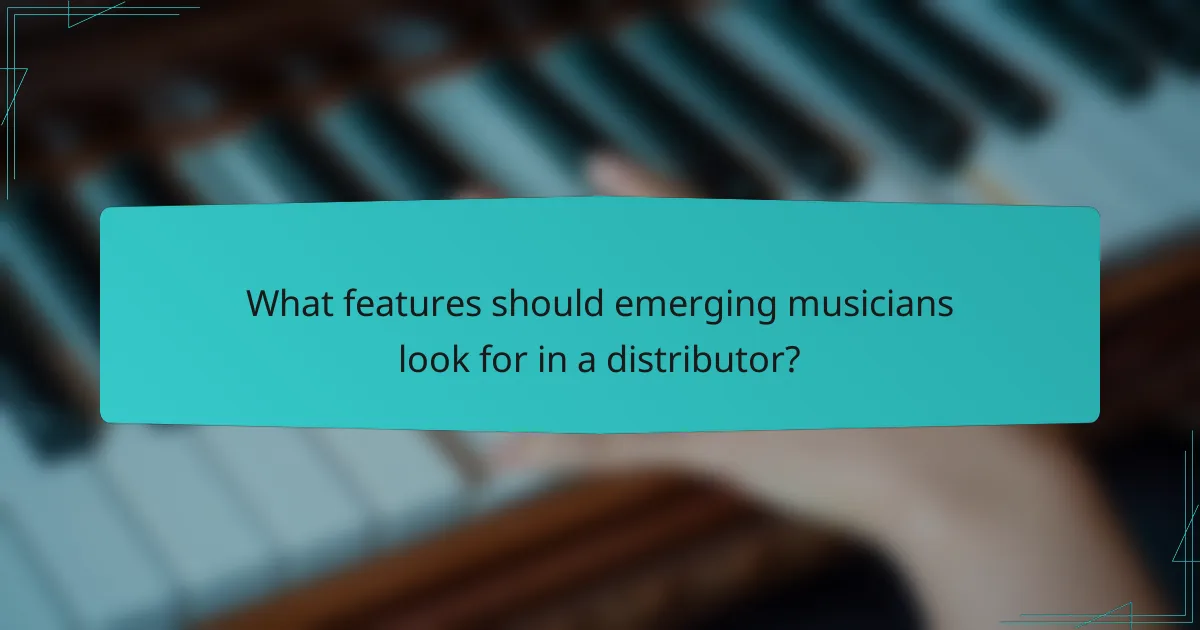
What features should emerging musicians look for in a distributor?
Emerging musicians should prioritize cost-effectiveness, global reach, a user-friendly interface, and reliable customer support when selecting a digital music distributor. These features can significantly impact their ability to distribute music efficiently and effectively.
Cost-effectiveness
Cost-effectiveness is crucial for emerging musicians, as they often operate on tight budgets. Look for distributors that offer transparent pricing models, such as flat fees per release or a percentage of royalties, which can help you manage costs effectively.
Some distributors may charge additional fees for services like promotional tools or analytics. It’s wise to compare these costs against the potential benefits to ensure you’re getting value for your investment.
Global reach
A distributor with a global reach allows musicians to access international markets, increasing their chances of gaining a wider audience. Check if the distributor partners with major streaming platforms and stores in various countries, as this can enhance your music’s visibility.
Consider whether the distributor supports multiple languages and currencies, which can make it easier for fans worldwide to purchase and stream your music. This feature is particularly important if you aim to build a fanbase beyond your home country.
User-friendly interface
A user-friendly interface simplifies the process of uploading music and managing releases. Look for distributors that provide intuitive dashboards and clear instructions, which can save you time and reduce frustration.
Some platforms offer drag-and-drop features for uploading tracks and artwork, making the process more efficient. Additionally, check for tutorials or guides that can help you navigate the system easily.
Customer support
Reliable customer support is essential for resolving issues that may arise during the distribution process. Choose a distributor that offers multiple support channels, such as email, chat, or phone, to ensure you can get help when needed.
Consider the availability of support, including response times and whether assistance is offered in your preferred language. Good customer service can make a significant difference, especially when you encounter technical difficulties or have questions about your account.
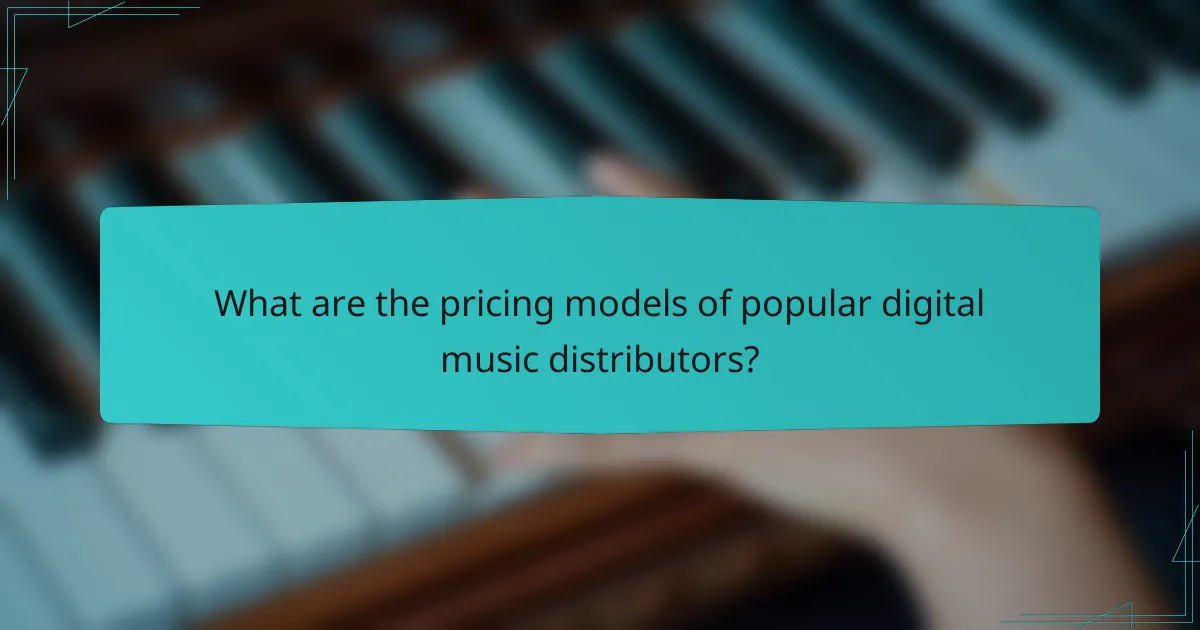
What are the pricing models of popular digital music distributors?
Digital music distributors typically operate under three main pricing models: flat fee per release, percentage of royalties, and annual subscription. Understanding these models helps emerging musicians choose the right distributor based on their needs and financial situation.
Flat fee per release
In this model, artists pay a set fee for each release, which can range from around $10 to $50 or more, depending on the distributor. This approach is straightforward and allows musicians to budget easily for each single or album they release.
However, artists should consider the number of releases they plan to produce. If they anticipate multiple releases within a year, a flat fee per release might become costly compared to other models. It’s advisable to calculate potential costs based on expected output.
Percentage of royalties
Some distributors charge a percentage of the royalties earned from music sales and streaming. This percentage typically falls between 10% and 30%. This model can be beneficial for artists who are just starting out and may not have a large volume of sales initially.
While this model reduces upfront costs, musicians should be aware that it can add up over time as their music gains popularity. It’s essential to read the fine print regarding what counts as royalties and any additional fees that may apply.
Annual subscription
Annual subscription models require artists to pay a yearly fee, which can range from about $50 to several hundred dollars, depending on the services offered. This model can be cost-effective for musicians who release multiple tracks or albums throughout the year.
When considering this option, artists should evaluate the features included in the subscription, such as promotional tools, analytics, and distribution to various platforms. It’s crucial to ensure that the benefits align with their goals to maximize the value of their investment.
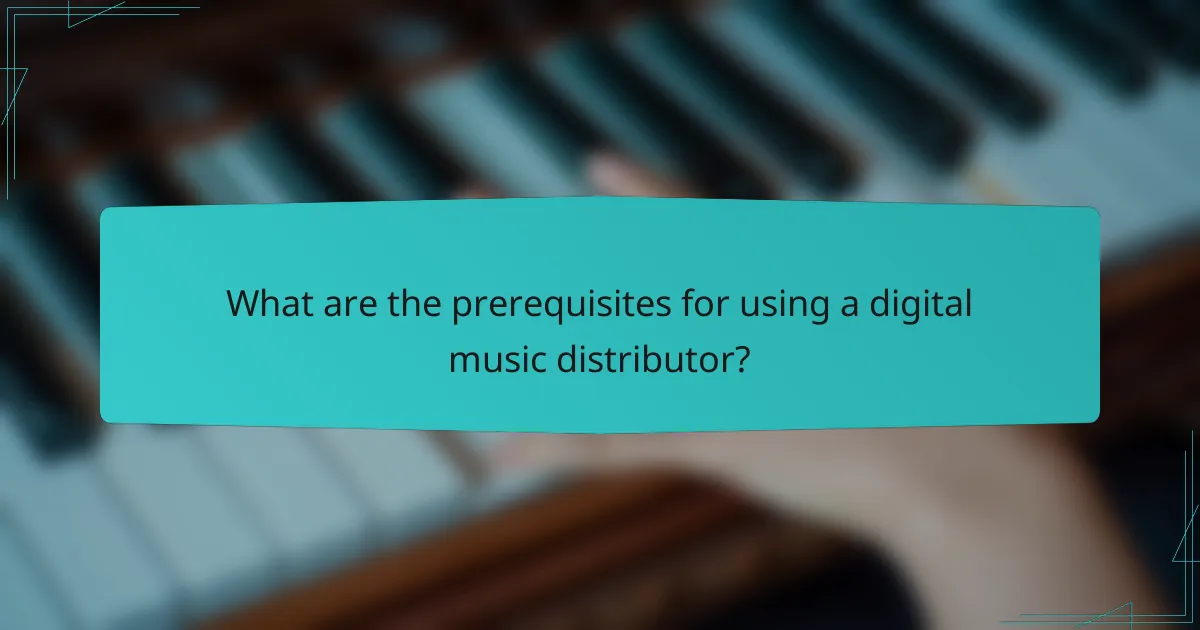
What are the prerequisites for using a digital music distributor?
To use a digital music distributor, musicians need to own their original music, provide high-quality audio files, and prepare accurate metadata. These elements ensure that the distribution process is smooth and that the music reaches the intended platforms effectively.
Original music ownership
Musicians must have full ownership rights to their original music before working with a digital music distributor. This means they should either be the sole creators or have explicit permission from co-writers and producers. Without proper ownership, distributors may refuse to process the music or could face legal issues.
It’s advisable to have written agreements or contracts that clarify ownership rights, especially when collaborating with others. This documentation can prevent disputes and ensure that all parties are on the same page regarding royalties and rights.
Quality audio files
Digital music distributors typically require high-quality audio files, often in formats like WAV or FLAC, to ensure optimal sound quality on streaming platforms. These files should be at least 16-bit/44.1 kHz to meet industry standards. Poor quality files may lead to rejection by the distributor or subpar listening experiences.
Before submission, musicians should check their audio files for any technical issues, such as clipping or distortion. Using professional mastering services can enhance the overall sound quality and increase the chances of acceptance by distributors.
Metadata preparation
Accurate metadata is crucial for digital music distribution as it includes essential information like song titles, artist names, and genre classifications. This data helps platforms categorize and promote the music effectively. Musicians should ensure that all metadata is complete and correctly formatted before submission.
Common metadata elements include track titles, album names, release dates, and ISRC codes. It’s beneficial to double-check this information for accuracy, as errors can lead to misattribution or delays in distribution. Using a metadata template can streamline this process and minimize mistakes.


